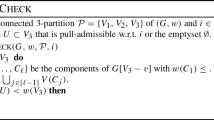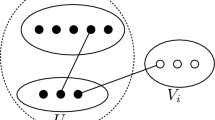Abstract
For a connected graph \(G=(V,E)\) and a positive integral vertex weight function \(w\), a max-min weight balanced connected \(k\)-partition of \(G\), denoted as \(BCP_k\), is a partition of \(V\) into \(k\) disjoint vertex subsets \((V_1,V_2,\ldots ,V_k)\) such that each \(G[V_i]\) (the subgraph of \(G\) induced by \(V_i\)) is connected, and \(\min _{1\le i\le k}\{w(V_i)\}\) is maximum. Such a problem has a lot of applications in image processing and clustering, and was proved to be NP-hard. In this paper, we study \(BCP_k\) on a special class of graphs: trapezoid graphs whose maximum degree is bounded by a constant. A pseudo-polynomial time algorithm is given, based on which an FPTAS is obtained for \(k=2,3,4\). A step-stone for the analysis of the FPTAS depends on a lower bound for the optimal value of \(BCP_k\) in terms of the total weight of the graph. In providing such a lower bound, a byproduct of this paper is that any 4-connected trapezoid graph on at least seven vertices has a 4-contractible edge, which may have a value in its own right.


Similar content being viewed by others
References
Alimonti, P., Calamoneri, T.: On the complexity of the max balance problem. In: Argentinian Workshop on, Theoretical Computer Science (WAIT’99) (1999) 133–138
Becker, R., Lari, I., Lucertini, M., Simeone, B.: Max-min partitioning of grid graphs into connected components. Networks 32, 115–125 (1998)
Becker, R., Lari, I., Lucertini, M., Simeone, B.: A polynomial-time algorithm for max-min partitioning of ladders. Theory Comput. Syst. 34, 353–374 (2001)
Bera, D., Pal, M., Pal, T.K.: An efficient algorithm to generate all maximal cliques on trapezoid graphs. Int. J. Comput. Math. 79, 1057–1065 (2002)
Bondy, J.A., Murty, U.S.R.: Graph Theory, p. 222. Springer, New York (2008)
Chataigner, F., Salgado, L.R.B., Wakabayashi, Y.: Approximation and inaproximability results on balanced connected partitions of graphs. Discret. Math. Theor. Comput. Sci. 9, 177–192 (2007)
Cheah, F., Corneil, D.G.: On the structure of trapezoid graphs. Discret. Appl. Math. 66, 109–133 (1996)
Chlebíková, J.: Approximating the maximally balanced connected partition problem in graphs. Inf. Process. Lett. 60, 225–230 (1996)
Dagan, I., Golumbic, M.C., Pinter, R.Y.: Trapezoid graphs and their coloring. Discret. Appl. Math. 21, 35–46 (1988)
Dyer, M., Frieze, A.: On the complexity of partitioning graphs into connected subgraphs. Discret. Appl. Math. 10, 139–153 (1985)
Fontet, M.: Graphes 4-essential. C. R. Acad. Sci. Paris 287, 289–290 (1978)
Galbiati, G., Mattioli, F., Morzenti, A.: On the approximability of some maximum spanning tree problems. Theor. Comput. Sci. 181, 107–118 (1997)
Ghosh, P.K., Pal, M.: An effcient algorithm to solve connectivity problem on trapezoid graphs. J. Appl. Math. Comput. 24, 141–154 (2007)
Györi, E.: On division of graph to connected subgraphs. In: Combinatoris (Proc. Fifth Hungarian Colloq., Koszthely, 1976), vol. I, Volume 18 of Colloq. Math. Soc. János Bolyai, North-Holland, Amsterdam, 485–494 (1978)
Lovász, L.: A homology theory for spanning trees of a graph. Acta Math. Acad. Sci. Hung. 30, 241–251 (1977)
Lucertini, M., Perl, Y., Simeone, B.: Most uniform path partitioning and its use in image processing. Discret. Appl. Math. 42, 227–256 (1993)
Ma, J., Ma, S.H.: An \(O(k^2n^2)\) algorithm to find a \(k\)-partition in a \(k\)-connected graph. J. Comput. Sci. Technol. 9, 86–91 (1994)
Maravalle, M., Simeone, B., Naldini, R.: Clustering on trees. Comput. Stat. Data Anal. 24, 217–234 (1997)
Martinov, N.: Uncontractible 4-connected graphs. J. Graph Theory 6, 343–344 (1982)
Nakano, S., Rahman, M., Nishizeki, T.: A linear-time algorithm for four-partitioning four-connected planar graphs. Inf. Process. Lett. 62, 315–322 (1997)
Perl, Y., Schach, S.: Max-min tree partitioning. J. ACM 28, 5–15 (1981)
Suzuki, H., Takahashi, N., Nishizeki, T.: A linear algorithm for \(2\)-partition of bi-connected graphs. Inf. Process. Lett. 33, 227–232 (1990)
Suzuki, H., Takahashi, N., Nishizeki, T., Miyano, H., Ueno, S.: An algorithm for tri-partitioning 3-connected graphs. J. Inf. Process. Soc. Jpn. (1990)
Thomassen, C.: Non-separating cycles in \(k\)-connected graphs. J. Graph Theory 5, 351–354 (1981)
Wu, B.Y.: Fully polynomial time approximation schemes for the max-min connected partition problem on interval graphs. Discret. Math. Algorithm. Appl. 04, 1250005 (2012)
Author information
Authors and Affiliations
Corresponding author
Additional information
The work is supported by NSFC (61222201), SRFDP (20126501110001), and by National Science Foundation of USA under grants CNS0831579 and CCF0728851.
Appendix
Appendix
The method to obtain an FPTAS from a pseudo-polynomial time algorithm is standard. For the convenience of readers, we present the proof for the FPTAS as follows.
Given a connected vertex-weighted graph \(G=(V,E,w)\) whose maximum degree is bounded by a constant \(K\). Suppose
where \(q\) is a constant and \(W=w(V(G))\) is the total weight of the graph. Let \(\mathcal A \) be the pseudo-polynomial time algorithm for \(BCP_k\) as described at the beginning of Sect. 5. Given a real number \(\varepsilon >0\), let \(\widetilde{G}\) be the graph having the same topology as \(G\) but a new weight \(\widetilde{w}\), where
Use \(\mathcal A \) on \(\widetilde{G}\) to compute an optimal connected \(k\)-partition \(\widetilde{\mathcal{P }}=(\widetilde{V}_1,\ldots ,\widetilde{V}_k)\) of \(\widetilde{G}\). Then, \(\widetilde{P}\) is also a connected \(k\)-partition of \(G\). We shall show that \(\widetilde{P}\) is a \((1-\varepsilon )\)-approximation solution of \(BCP_k\) on \(G\).
Suppose \(\mathcal P ^*=(V_1^*,\ldots , V_k^*)\) is an optimal solution of \(BCP_k\) on \(G\). Use \(apx\) to denote the approximation value. Then \(apx=\min _{i=1,\ldots ,k}w(\widetilde{V}_i)\). Since \(\widetilde{P}\) is an optimal solution of \(BCP_k\) on \(\widetilde{G}\), we have
For each vertex \(v\in V\),
Thus
Hence \(apx\ge (1-\varepsilon )\beta ^*(G,k)\).
By the second paragraph of Sect. 5, the time complexity is \(O(n(n^{2K}\widetilde{W})^{k-1})\). Since \(\widetilde{W}=O(W/p)=O(n/\varepsilon )\), the time complexity is \(O(n^{((2K+1)(k-1)+1)}/\varepsilon ^{k-1})\).
Rights and permissions
About this article
Cite this article
Wang, L., Zhang, Z., Wu, D. et al. Max-min weight balanced connected partition. J Glob Optim 57, 1263–1275 (2013). https://doi.org/10.1007/s10898-012-0028-8
Received:
Accepted:
Published:
Issue Date:
DOI: https://doi.org/10.1007/s10898-012-0028-8




